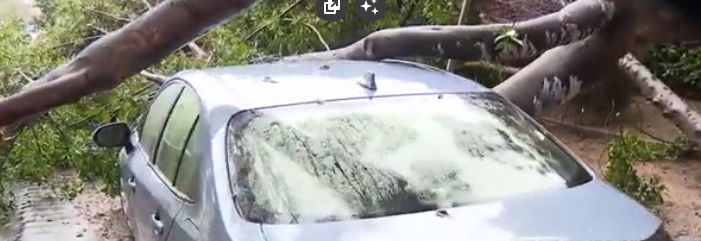California’s Storm Struggle: Confronting Nature’s Fury with Resolve
California, known for its diverse landscapes and temperate climate, is currently in the throes of a series of natural disasters that have shaken communities across the state. From flooding to mudslides, California is facing a potent storm system that has unleashed havoc along its coast and mountain regions. This sustained onslaught, attributed to an atmospheric river phenomenon, has brought forth not only heavy rainfall but also damaging winds and significant snowfall, testing the resilience of residents and emergency response teams alike.
As the state enters its third day under the influence of this atmospheric river, the situation remains dire, with moderate to heavy rains persisting across various regions. Particularly hard-hit are the mountains north of Santa Barbara, where rainfall levels are nearing the double-digit mark. The forecast predicts another day of intermittent heavy downpours and isolated thunderstorms, posing further threats to already precarious conditions.
The atmospheric river phenomenon, often described as a long, narrow corridor of concentrated moisture in the atmosphere, is responsible for the intense precipitation California is experiencing. These atmospheric rivers can transport vast amounts of water vapor from the tropics to higher latitudes, leading to heavy rainfall and, in some cases, extreme weather events. While they are a natural part of the Earth’s climate system, their impact can be severe, especially when they make landfall in areas prone to flooding and landslides, like California.
In addition to the immediate threats posed by flooding and mudslides, the storm system has also brought damaging winds to parts of the state. High winds can exacerbate the impact of heavy rainfall by downing trees and power lines, causing power outages and property damage. In mountainous regions, strong winds can create blizzard conditions, making travel treacherous and increasing the risk of avalanches.
Significant snowfall has also been reported in higher elevations, adding to the challenges faced by residents and emergency responders. While snow is a vital source of water for California’s water supply, heavy snowfall can lead to road closures, disrupted transportation networks, and increased avalanche danger. Mountain communities are particularly vulnerable during these storms, as access to essential services and supplies may be limited.
The widespread impact of the storm system has prompted officials to issue flood watches and warnings across much of California. From the coastal communities of Eureka to the agricultural heartland of the Central Valley, millions of residents are on alert for potential flooding and flash flood events. Emergency response teams are on high alert, preparing for swift water rescues and evacuations if necessary.
The looming danger is expected to persist in the coming days, as the storm system shows no signs of abating. With more heavy rainfall forecasted, the risk of flooding and mudslides remains high, especially in areas that have already been saturated by days of precipitation. In addition to the immediate threats, there are also concerns about the long-term impacts of the storms, including damage to infrastructure, disruption of transportation networks, and potential environmental consequences.
Despite the challenges posed by the storm system, Californians have shown resilience in the face of adversity. Communities have come together to support one another, offering assistance to those in need and working together to mitigate the impact of the storms. Emergency response teams have been working around the clock to ensure the safety and well-being of residents, conducting rescue operations and providing essential services to affected areas.
As California continues to weather the storm, it serves as a reminder of the importance of preparedness and resilience in the face of natural disasters. Climate change is expected to bring more frequent and intense extreme weather events in the future, making it essential for communities to invest in infrastructure, emergency response capabilities, and disaster preparedness efforts. By working together and taking proactive measures to reduce risk, Californians can build a more resilient future for themselves and future generations.

